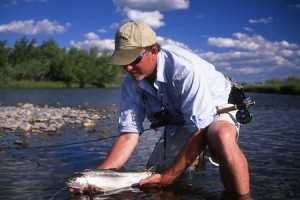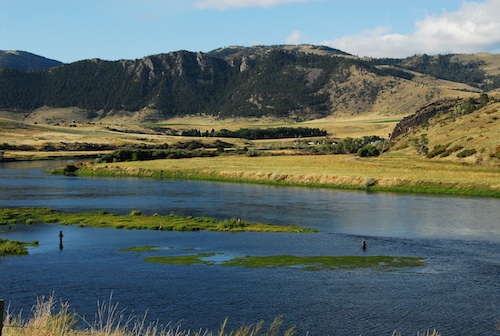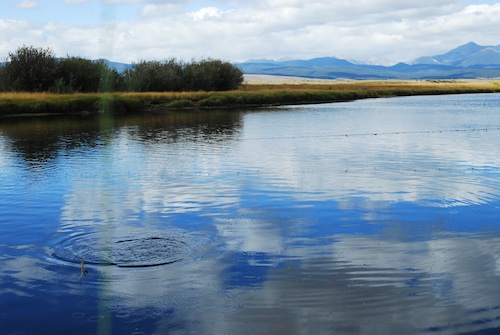 I penned this story years ago but it remains relevant. Tricos are out on many western rivers right now, including the Clark Fork and Bitterroot in my backyard, and on the Missouri a couple hours away, so get out there early and test yourself during this great hatch of tiny bugs.
I penned this story years ago but it remains relevant. Tricos are out on many western rivers right now, including the Clark Fork and Bitterroot in my backyard, and on the Missouri a couple hours away, so get out there early and test yourself during this great hatch of tiny bugs.
The diminutive trico—also known as the “white-winged curse”—causes more frustration than any other mayfly. But it’s not so hard to fish the hatch if you know a few basic rules.
Last year I visited Idaho’s famous Silver Creek, armed with a nine-foot, four-weight fly rod, a spool of 6X tippet material, and a fly box loaded with size-24, olive-bodied CDC Trico Comparaduns. By 7 a.m., great clouds of trico spinners, literally millions of them, swarmed above the creek.
Large trout began sucking unfortunate stillborns and fallen spinners off the surface. In one 10-yard swath, perhaps 20 mature fish turned a typically flat-surfaced corner into a riffle, their snouts breaking the surface every half-second or so. Up and down the creek, no matter where I looked, dark shapes exited the water.

You’ll find Tricos on Montana’s Missouri during August. Match wits with those big rainbows and browns and you’ll have a blast.
I picked the largest fish, entered the water upstream, and dead-drifted a Comparadun into its lap. First cast, he ate and I fought that fish carefully. Three minutes later I loosened my grip on the tail of a 21-inch brown and watched him swim away.
Trico hatches and spinner falls can turn large trout into aggressive surface feeders, and the trico season is one of the best opportunities of the year to take large fish off the top. Yet, when you hear fly anglers discussing the trico hatch they usually talk about how frustrating it is. Then they fondly recall the “big bug” hatches, such as stoneflies and green drakes.
From the maddening task of knotting a tiny dry fly to a wispy-thin leader, to the demands that a 20-inch trout places on a size 22 hook and a 6X or 7X tippet, matching tricos can be a demanding job. But, armed with some basic knowledge—and patience—any fly angler should be able to master the trico hatch.

Montana’s Big Hole River is another good Trico locale in August. The flat-water upstream sections produce nicely.
Tricos (technically, Tricorythodes minutus) range from size 18 to size 24. Males emerge in the evening and spend the night in streamside vegetation as duns. Females emerge in the morning, usually around 6 or 7 a.m., and transform to spinners within a few hours.
While females emerge, males take wing and molt into spinners. They form giant, oscillating clouds and fly upstream, searching for that one lucky female spinner. Having mated, the female quickly lays eggs. Males drop to the surface, either with a smile or a frown on their face, depending on their success.
Although duns and spinners are usually on the water at the same time, I typically tie on a dun pattern for two reasons: first, it’s easier to see than a flat spent-wing spinner pattern; and second, the trout don’t seem to mind. Occasionally, late in the spinnerfall when just a few bugs are left in the air, I encounter large trout that are focused on spent-wing spinners. That’s when I tie on a Poly Wing Spinner pattern.
Generally, however, presentation is more important than matching a particular color or life stage of the trico. In fact, rather than enticing a fish to eat—they eat tricos constantly—the challenge is getting a fish to eat your fly when so many naturals are on the surface. Following the drift of a size 22 or 24 dry fly on a choppy surface is almost impossible. Often, fly fishers must time the rise of a trout and try to present their fly just as that fish parts the surface.
That’s where patience becomes a virtue: easy-going anglers should excel; those who are less patient may not. Hint: if you endure difficulty following your fly through a pod of risers, move up or downstream and search for single fish.
No matter where you fish tricos this season, whether that’s on Silver Creek, the Henry’s Fork, the lower Clark Fork or Bitterroot, bring a little patience, along with that 6X tippet material and some size 22 Comparaduns. With the right attitude and a dead drift, you shouldn’t have any problem getting eats.

One Response to Tactics for Tricos